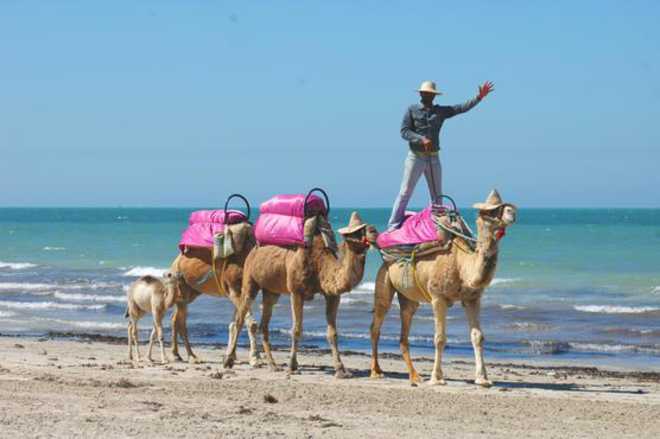Krishnaraj Iyengar
Tunisia is like a streak of blue and white Claude Monet eccentricism freeze-framed, with a rustic kaleidoscope of colours sprinkled-in.
The lazy lilt of the moorish rabeb flirts with a captivating bouquet of amber, wardah (rose) and Oud, the earthy gruff of the local Arabic and the silky swish of Parisian French. As you juggle the uneven cobbled pathways of the Medina, the old quarter of Tunis, Tunisia’s capital, leaves a permanent passion mark on your spirit. The dazzle of traditional artefacts, musical instruments, carpets and perfumes overwhelms the traveller leaving no courage to bargain. Brazenly trying to guess your nationality, especially if you happened to look even remotely Arabic, the hot-blooded lads trace ‘discount’ to an alien dictionary while the elderly are the endearing salesmen scaling-down their prices for a smattering of Arabic.
Driving down the narrow alleyways of Tunis brings you to the surreally stunning Andalusian village suburb of Sidi Bou Said, the romance of this Mediterranean marvel leaving poets dry-penned. The charming Persian-style garden, musical instrument museum, fairytale architecture and souvenir market take you back to the era of Arabic Spain. A haven for romantics, Sidi Bou Said plays host to writers, travellers and lovers from all over the world round the year.
Being Africa’s northernmost country, though small in its size, Tunisia boasts of several diverse influences throughout its ancient history — the Romans, Greeks, Spanish, Arabs — each leaving their distinct mark on its mosaic.
Tunis’s Bardo Museum unveils the several eons witnessed by the country with some of the world’s most stunning artefacts and mosaics on display dating back to various eras in Tunisia’s history.
With the pristine blue Mediterranean and Italy to its north, Libya to the east and Algeria to the west, Tunisia, a part of the ‘Maghreb el Arabi’ or the ‘ the Western Arab World’ is a land of astounding geographical diversity right from seaside Tunis in the North to the forbidding Sahara in the centre, the west and the south. Driving down the eastern coast from Tunis gets you to Monastir, a relaxed, colourful Mediterranean city and a ship gazer’s paradise. Walking down the centre ville or downtown is a rendezvous with eye-popping traditional shops, cafes and affable locals while atop the Ribat fortress, a panorama of the city and its seascapes unfolds as you stand leaning against the rampart with ‘Uhibbuk’ ( I love you in Arabic) scribbled in careless calligraphy.
Another short drive and you land in the historic town of Kairouan where stands the majestic Masjid Al Uqba, a place of great religious significance in the Arab World. The formidable, yet exquisite, structure with an ancient sun dial in its courtyard attracts both Muslim and non-Muslim tourists from around the globe. To witness Africa’s most impressive Roman ruin, the town of El Jem hosts the sprawling Roman amphitheatre that still bears the vibrations and impressions of the Roman Empire.
Onward into Tunisia’s interiors, the breathtaking expanse of the Sahara unfolds before your eyes as you drive through 360º of nothingness. The circumference of the earth kissing the sky in a seamless horizon leaves you intimidated yet in a mystical trance. Occasional trysts with indigenous desert farers at their hut-shops might take you several thousand miles back home with Kareena Kapoor on mehendi packets, incense sticks and other Indian-made products on display, not to forget, a crude imitation of a Bollywood bhangra by a passing herdsman or a Yash Chopra-hit playing at a makeshift barber shop!
The Saharan town of Tozeur is the abode of tranquility, the romance of its quaint, dusty pathways, the zigzag maze of the Medina, Sufi culture, date plantations and the hometown of Tunisia’s national poet Abul Qasim el Chaabi have a magnetic charm. While Douz, another Saharan dreamland, is the place to splurge on traditional products, Tuareg jewellery, essential oils and watching hardy locals immersed in card games under trees all afternoon, Matmata, famed for its Star Wars connection, is a tête-à-tête with the Berber community, elderly grannies offering ‘Taa’ee’ (tea) and home-baked goodies to guests, the language barrier being of no consequence to the legendary hospitality.
The highlight of a classic Tunisian sojourn is its south-eastern wonderland, Djerba, known as ‘Lile des Reves’ or Island of Dreams in French. Known for its very distinct and unique culture, Djerba is also the world’s greatest example of Jewish-Arab brotherhood despite lethal conflict between the two communities. Apart from housing the grand old El Ghriba Synagogue, Djerba is probably the only place on earth where one can dine in a Jewish restaurant plunk in the Arab world.
Along with its pristine beaches, Djerba boasts of one of the world’s most colourful markets at Houmt Souk, a dazzling array of both traditional and modern boutiques draw-in international tourists round the year. While recreation of old pirate ships ferry tourists to the nearby Pink Flamingo Island, soirees of traditional folk music and belly dancing enthral aficionados of all nationalities at Djerba’s plush nightclubs.
FACT FILE
There are no direct flights from anywhere in India while several airlines fly to the capital Tunis via Europe and the Middle East.
Getting around Tunisia is best done by road.
On can also fly from Tunis to Djerba Island and back. English-speaking guides and chauffeurs are at your disposal.
Although Arabic and French (being a former French colony) are spoken in Tunisia, English is widely understood.
Tunisia is known for shopping, traditional cuisine and wine, history, music and natural beauty.
The currency is Tunisian Dinar.
Visas are available to Indians at the Embassy of Tunisia in New Delhi.
Unlock Exclusive Insights with The Tribune Premium
Take your experience further with Premium access.
Thought-provoking Opinions, Expert Analysis, In-depth Insights and other Member Only Benefits
Already a Member? Sign In Now










